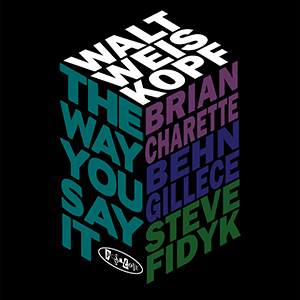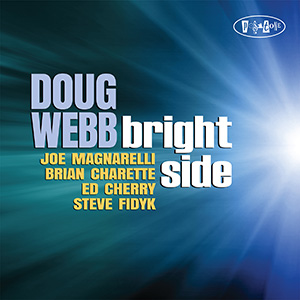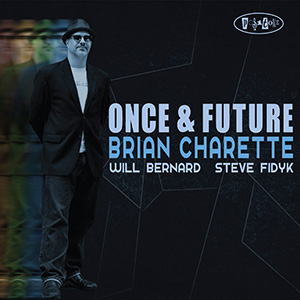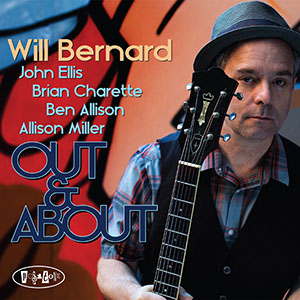 Saxophonist and composer Walt Weiskopf has been a major contributor in the New York (which is to say, world-wide) jazz scene since the early 1980s. After completing studies at the prestigious Eastman School of Music, Weiskopf joined the Buddy Rich Big Band followed by a fourteen-year tenure with the Toshiko Akiyoshi big band. During his time with Akiyoshi and beyond, Weiskopf began recording his own albums playing almost exclusively original music with a variety of groups. Weiskkopf also began his long-running and current association with Steely Dan.
Saxophonist and composer Walt Weiskopf has been a major contributor in the New York (which is to say, world-wide) jazz scene since the early 1980s. After completing studies at the prestigious Eastman School of Music, Weiskopf joined the Buddy Rich Big Band followed by a fourteen-year tenure with the Toshiko Akiyoshi big band. During his time with Akiyoshi and beyond, Weiskopf began recording his own albums playing almost exclusively original music with a variety of groups. Weiskkopf also began his long-running and current association with Steely Dan.
In addition, Weiskopf has become one of the most respected authors in jazz pedagogy starting with his first two books, Coltrane: A Players Guide to His Harmony and The Augmented Scale in Jazz (both co-authored with Ramon Ricker). Other books that followed include Intervalic Improvisation (1994), Around the Horn (2001), Beyond the Horn (co-authored with Ed Rosenberg)(2010) and Understanding the Diminished Scale (2012). Weiskopf has been on the faculty of the Eastman School of Music, Temple University and is currently Coordinator of Jazz Studies at New Jersey City University.
The Way marks Weiskopfs third CD as leader for Posi¬tone, besides at least another dozen for other labels, and represents a change in format, in that Weiskopf uses a modified organ trio as his vehicle of choice. The music, as is his custom, is almost all original, with the exception of three tunes.
To say that Weiskpopf is a master saxophonist is to overstate the obvious. Weiskopf has a clear, clean, centered sound, lickitey-split technique and personality to spare. That covers the “How To Play” side. On the “What to play” side, Weiskopfs melodic, harmonic and rhythmic acumen are massive. All of these attributes are eminently clear in the opening track, a medium-up-tempo blues, Coffee and Scones.
The quirky melody is played by unison tenor and vibes with Weiskopf taking the first solo. As mentioned before, Weiskopf has lots of personality in his playing, beginning with the fact that he plays with no vibrato at all and ends long pitches by just stopping the air, no taper at all. Both of these conditions contribute to his unique voice, but there’s more. Yet another factor are the notes and harmonies that Weiskopf uses. Each chorus that he plays finds him going down a different harmonic path, allowing him to keep the listener interested and on the edge of their seat all at once. Good solos by Gillece and Charette as well.
Inntoene, a barnburner taken at warp speed, is an example of good straight-a-head blowing. Tenor and vibes play the intricate melody once again, with Weiskopf taking the first solo, barreling down the highway, dropping one cleanly executed line after another like some many bombs over his shoulder.
The first of the tunes not written by Weiskopf is the now obscure Candy, by Alex Kramer (lyrics by Mack David & Joan Whitney). Performed as a ballad, for me, this is the money tune of the recording. Weiskopf plays the melody and goes right into his solo chorus paying homage to John Coltrane, with a touch of Jerry Bergonzi. His reading of the melody is just beautiful, and his solo is a study in “this is what a jazz player should be able to do with a tune,” playing it from every angle while still keeping all the music intact.
Segment, by Charlie Parker is another up-tempo gem, with Weiskopf and company just gliding through the changes and the changes of key with ease. Again, Weiskopf displays a complete understanding of harmony and the post-bebop language.Never at a loss for an idea, his lines just flow from one to the other. After a brief two-chorus romp from Weiskopf, Gillece plays his own well executed solo. Tenor and vibes trade eights, then fours for a chorus each before a shout chorus and the final reading of the melody.
The title tune, a prety ballad by the leader closes the CD. The melody is shared by tenor and vibes followed by short solos by Charette and Weiskopf. The mellow feel of the tune lets you down easy after the action packed recording.
Walt Weiskopf is a power with which to be reckoned; if you are not familiar with his playing, this recording is a great place to start to get to know him.
Billy Kerr – Saxophone Today
 This is a direct descendant of the kind of jazz record that took jazz from smoky, late night New York clubs to the rec rooms of then nascent suburban sprawl. With a crew of leaders backing up the first call sax man, this is a perfect example of where jazz meets commercial vibes and coming out none the worse for wear. Pure jazz for pure jazzbos, listening dates don’t come any Better than this. Well done.
This is a direct descendant of the kind of jazz record that took jazz from smoky, late night New York clubs to the rec rooms of then nascent suburban sprawl. With a crew of leaders backing up the first call sax man, this is a perfect example of where jazz meets commercial vibes and coming out none the worse for wear. Pure jazz for pure jazzbos, listening dates don’t come any Better than this. Well done. In every jazz lover’s mind there exists the perfect Hammond B-3 organ player. Whether that ultimate B-3 technician is Jimmy Smith, Charles Earland, Larry Young or Shirley Scott, certain defining parameters exist, regardless of the individual player.
In every jazz lover’s mind there exists the perfect Hammond B-3 organ player. Whether that ultimate B-3 technician is Jimmy Smith, Charles Earland, Larry Young or Shirley Scott, certain defining parameters exist, regardless of the individual player. It’s never an easy ask, playing Will Bernard’s whimsical music. Then playing it well. Then playing it this well. But this quintet led by none other than Will Bernard himself makes it seem so elemental and easy. And mind you this repertoire might seem easy if you read the names of the tunes out aloud. But make no mistake the music is diabolical but if this benchmark recording is a significant one it is only because of the musicians who are on it. Bernard aside, who could fault the intellect and intuition of John Ellis, Brian Charette, Ben Allison, and Allison Miller?
It’s never an easy ask, playing Will Bernard’s whimsical music. Then playing it well. Then playing it this well. But this quintet led by none other than Will Bernard himself makes it seem so elemental and easy. And mind you this repertoire might seem easy if you read the names of the tunes out aloud. But make no mistake the music is diabolical but if this benchmark recording is a significant one it is only because of the musicians who are on it. Bernard aside, who could fault the intellect and intuition of John Ellis, Brian Charette, Ben Allison, and Allison Miller?